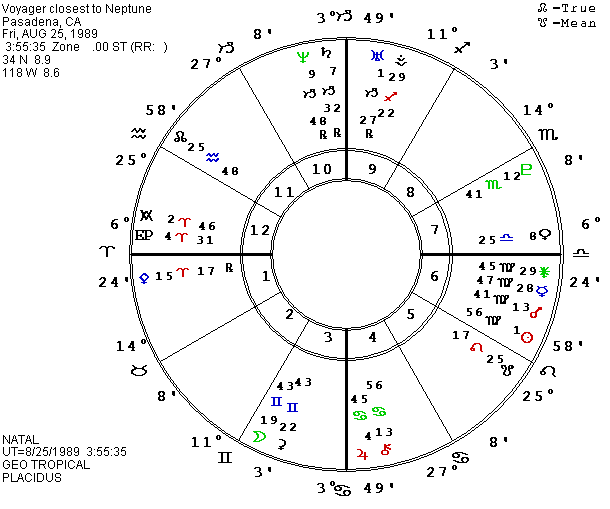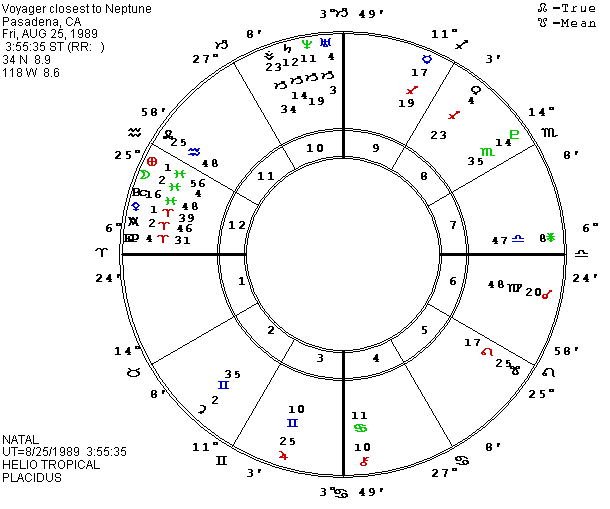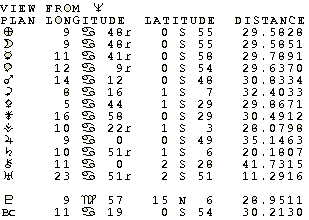Voyager 2 Reaches Neptune
Zip Dobyns
The U.S. spacecraft Voyager 1 visited Jupiter and Saturn and sent back pictures of these closer two planets of the four gas giants in our solar system. Voyager 2 was also originally programmed to fly by Jupiter and Saturn, but the Jet Propulsion Lab (JPL) scientists were able to remotely reprogram it so that it also passed close to Uranus and Neptune. It was launched from earth on August 20, 1977; passed Jupiter on July 9, 1979; passed Saturn on August 25, 1981; passed Uranus on January 24, 1986; and made its closest approach to Neptune on August 25, 1989 at 3:55:35 A.M. UT. The enclosed chart is calculated for Pasadena, CA, the home of JPL where scientists (and journalists) stayed up all night to watch the spectacular pictures come in as the spacecraft flew by Neptune, its rings and its moons. The inner circle shows the geocentric positions of the planets at Voyager’s closest approach, while the outer circle of the chart shows the heliocentric positions, the view from the Sun.


The horoscope is appropriate for the occasion. Geocentric (G) Jupiter is exactly on the IC while Heliocentric (H) Uranus is exactly on the MC (defining ‘exact’ as within a one-degree orb). Jupiter symbolizes higher “truth” including universities, while Uranus symbolizes the quest for “new” knowledge and new technology. Mercury, our third mental planet, was strongly placed in double Virgo (sign and house) along with the Sun (self-esteem and creativity), Mars (personal action and power) and Juno (who seeks teamwork and inner knowledge like Pluto). The Gemini Moon conjunct Ceres (nurturing work) adds to the mental emphasis in the chart, wanting to know a little about everything with the Gemini sign and house but wanting to apply the knowledge with the Virgo overtones of Ceres. Vesta, the super-Virgo asteroid, was in the house of Sagittarius closely conjunct G Uranus in the same house but in early Capricorn. The high focus on Jupiter, Sagittarius and the ninth house fit the long trip to foreign countries. The exact trine of Uranus to the Sun in earth signs fits the practical, productive work which brought success. In addition to the normal mental planets, Pallas also carries the connotations of wisdom (she was born from the forehead of Jupiter) and teamwork (with Libra qualities}. Her position in the Aries sign and house is appropriate for a pioneering venture. H Pluto was exactly on its own eighth cusp, repeating the emphasis on team effort which led to deeper insights. Chiron, which is much like Jupiter in its search for Truth, was trine Pluto and sextile Mars to repeat again the theme of a successful search for understanding. Venus in its own sign and house again pointed to the shared actions of hundreds of people who made the triumph possible, and also to the celebration with Champaign during that exciting night. The Aries Ascendant, East Point, and Antivertex testify again to the pioneering accomplishment.
The new asteroids were less impressive than in many charts, but there were some appropriate aspects, especially with the heliocentric (H) positions. H Urania (which I interpret as similar to Uranus, connected to new knowledge), was conjunct H Pallas. H Edisona (named for a famous inventor) was conjunct the Antivertex to the minute of longitude. H Wisdom was on the south lunar node. H California was on H Pluto and H Pasadena was on H Neptune, pinpointing the location of the scientists who controlled the spacecraft. H Washingtonia was on Saturn, the source of the decision and the money to attempt the project. Only aspects within a one degree orb are listed.

One of the amusing sections of Mark’s CCRS computer program will calculate where the rest of the planets are seen from each of the planets in the solar system. I thought it would be interesting to see the view from Voyager 2 as it made its closest pass by Neptune, to contrast with the view of the JPL observers here on earth. The farther out the planet, the more closely bunched are the rest of the planets as a hypothetical observer looks inward toward the center of the system. And, just as the earth will be in the opposite sign when seen from the Sun as the Sun’s sign when seen from earth, Neptune sees all of the solar system except Pluto in the opposite sign from the one in which it appears to us on earth. So Voyager 2 looked back at its home, its roots, at a solar system seen against the sign of Cancer, as we saw it working precisely and effectively conjunct Saturn in the sign and house of Capricorn. Mission accomplished.
Many scientific magazines have carried reports and pictures of the new knowledge gained by the Voyagers. The November 1989 issue of Scientific American offers some beautiful photographs of the “blue” planet, with its great dark spot which is similar to the great red spot on Jupiter. Of course we are delighted that our fire planets are red (Mars) or have a red spot (Jupiter) while our water planet Neptune is blue. Neptune’s color is due to the absorption of light from the Sun by the methane in the atmosphere. The great rotating vortices on the two planets which symbolize spirituality have been metaphorically called eyes of God. Neptune is also “one-up” on Jupiter since it has a second, smaller dark spot in addition to some unique white clouds. One small white spot has been named “Scooter” in reference to its rapid movement which matches the rotation rate of the planet. The Voyagers discovered that all of the gas giants have rings though Saturn’s are the most visible and dramatic. Additional, previously unknown moons were also discovered for each of the four planets visited by the Voyagers. Scientists were particularly fascinated by Triton which may once have been an independent planet like Pluto that was captured by the gravitational field of Neptune. Triton may still have active “volcanoes” of liquid nitrogen, joining Jupiter’s moon Io and earth as the only known bodies in the solar system with active volcanoes. Triton is the only large moon in the solar system to rotate in the retrograde direction and is reported to be the coldest known body in our system. It is thought that Triton’s frozen lakes were once water. Nereid is the other Neptunian moon which had been previously seen from earth. Closer inspection suggested that it is very similar to Chiron.
Voyager 2 is now traveling south out of the solar system. Its plutonium power sources are expected to last until around 2015, and scientists hope that before that time, it will meet the heliopause, the true edge of the solar system and will send one more burst of information back to earth.